

|
Home Updates Hydros Cars Engines Contacts Links Contact On The Wire Next→ Page 1 2 3 |
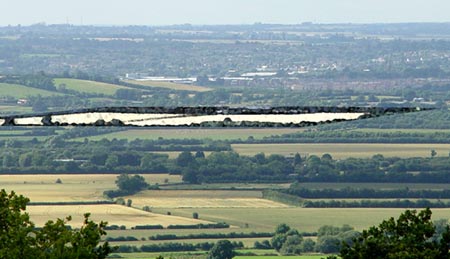
The site of Eaton Bray from Dunstable Downs
Modelling activities in Britain have always experienced opposition and had restrictions imposed, which have increased dramatically of late. Issues of noise and pressure through commercial and leisure development continue to impact on the hydro lakes and flying sites available. The situation for tethered cars has been even more difficult with no tracks at all in this country since the demise of Mote Park, Maidstone in the 70’s. Enthusiasts would love to see a track established in this country and model flyers continue to petition the BMFA to create a central flying site. Yet sixty years ago, such a facility did exist. This was the Model Sportsdrome at Eaton Bray in Bedfordshire, and the man behind this modelling mecca was D.A. Russell the Managing Editor of the ‘Aeromodeller’.
Even to this day the name ‘Eaton Bray’ invokes nostalgic reminiscences in a certain generation. This was something new and exciting and large numbers of people would travel from all over the country and much of Europe to attend events. Such was the enthusiasm of many competitors that they even went to the extent of cycling from as far away as the south coast or Scotland. As well as a centre for modelling it became the hub of Russell’s extensive business empire, yet by the early 50’s the entire venture had collapsed.
Some 50 years on, articles began to appear in a range of club magazines that rekindled interest in Eaton Bray. The information presented seem very limited which determined me to find out more about the Sportsdrome, the man behind it, and the reasons for its demise.
Douglas Arthur Russell was born in Southend-on-Sea in 1902, attended school in Westcliff-on-Sea, and then Uppingham School, Rutland. His father, Charles Arthur Russell ran his own business involved with the making of stays for corsetry. Charles’ death at the age of 43 in 1914 left Helena, his wife, with three young children Douglas 11, Winifred 9 and Ronald 8.
In 1921 Douglas started his four-year apprenticeship with W H Allen and Sons Co Ltd, at Queen’s Engineering Works, Bedford. He was a ‘premium’ pupil trained in electrical and mechanical engineering, working with steam engines and turbines, pumps, oil engines, electric motors and generators, not only in the maintenance and testing but also in the erection of turbine-generators. His notebook for 1923 shows detailed drawings and notes of his involvement in the building of condensing plants at Greenwich and Bexhill. Douglas moved in 1925 to Messrs British Insulated Cables Ltd of Prescot, Lancashire, and worked for them in various capacities, including the design and construction of supply cabling to power stations in Barking, Islington St Pancras and Marylebone. During this period he was living in Ilford and it was there that he married Grace Brentnall in 1927.
|
|
Another move in 1935 brought him to Corby with Messrs Stewarts & Lloyds Ltd. His role as Night Manager of the Tube Works saw him in charge of a very busy mill, producing 3,500 to 5,000 tons of tube per week and with a work force of 1,500. Although he was now in a highly responsible position in the engineering industry Douglas had developed what would become a lifetime interest in aviation. He would have loved to have been a pilot, but unfortunately his eyesight was not up to the required standard. However, he was a keen aeromodeller and produced petrol driven flying models on a grand scale bearing the G-A DAR registration. Left: Douglas in the 1930s |
A 10ft span, low wing monoplane was built in 1935 with an 18cc Comet engine, which won a Highly Commended diploma at the 1935 Model Engineer Exhibition. This plane was pictured being launched from the open roof of a car in its early trials. There was an A M Cyclonic in 1938, and a ‘Vulcan’ with an 8-foot wingspan and Dennymite engine in 1939. Work also started in 1939 on the 1/5th scale Lysander with a 4-cylinder Ferguson Condor engine. The Condor engine from the Lysander was offered for sale at Gildings auction in 2003
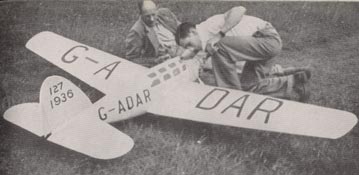 |
 |
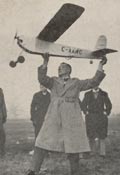 |
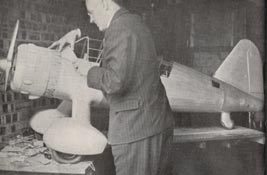 |
|
Experimental monoplane built in 1935, weighed 14lbs- the car launch |
Cyclonic | 1/5th scale Lysander | |
Douglas recorded the details and building of each model in notebooks, which were put to good use when he became an early contributor to the ‘Aeromodeller’ magazine that had been started in 1935 by Barron-Dean Publishing. Unfortunately payment was not forthcoming for his articles, and in May 1937 after 18 issues he added £200 to the debt and took over the magazine. So issue #19 of the Aeromodeller in June 1937 was the start of what became a very successful venture for Douglas.
|
It was a busy year as he also set up Harborough Publishing Co, so named as the family were living in Market Harborough at this time. Douglas used the logo of ‘Pegasus’, which he referred to as a ‘Colophon’. Offices at Allen House, Newark Street, Leicester, became his business address, although initially publishing was part-time. The first of several books Douglas published under the Harborough banner, was his own, ‘The Design and Construction of Flying Model Aircraft’ in 1937 which went on to be revised several times. Harborough’s most well known series was ‘Aircraft of the Fighting Powers’ which ran to seven volumes. Another company, whose name was to be synonymous with modelling for many decades, also came into being in 1937. This was the ‘Model Aeronautical Press Ltd’ or MAP, with the ‘Aeromodeller’ magazine, under its banner. |
|
Publishing was only a part of his business interests as in February 1937 Douglas had formed what was possibly the first of the many companies in which he would be involved. This was DAGRA Engineering Co Ltd, an acronym of Douglas Arthur and part of his wife’s name Grace. What its purpose was then is not clear but it later became the highly successful model-making arm of his business. A number of high profile model makers worked for DAGRA including Eric Pullen and Doug McHard producing fine quality aeronautical and engineering models commissioned by most of the major companies, including Rolls Royce. Later the company would be managed by Phil Smith who became best known for his work with Veron. Whilst there was a huge demand for this type of model for many years the post-war decline in the aircraft industry also had a serious impact on DAGRA, eventually leading to it being wound-up voluntarily in 1956.
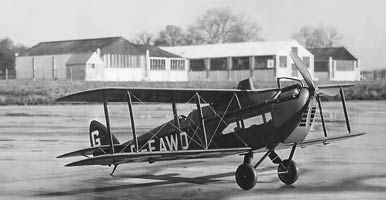 |
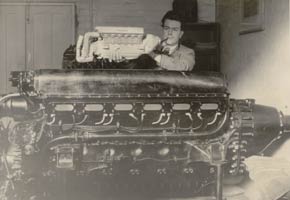 |
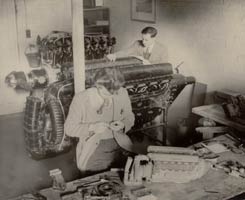 |
|
Model of a de Havilland DH18A G-EAWO |
Rolls Royce loaned a full sized 'R' engine to create a ¼ scale model for them |
|
The de Havilland produced by DAGRA Engineering Company nicely positioned with the new E-shaped main building in the background c 1947. The model sits on one of two concrete circles that served a variety of purposes and were clearly visible to visitors arriving by air. The full-size Daimler Air Hire DH18A collided with a French Goliath on 17 April 1922 about 70 miles north of Paris and entered the history books by way of being the first ever mid-air collision by airliners.
Douglas continued working for Stewarts & Lloyds of Corby until April 1940 when he joined London Electric Wire Company and Smiths Ltd, as the Personal Engineering Assistant to the Managing Director earning a salary of £900. He was responsible for the design and construction of a new factory after the old one had been bombed. In 1942 Douglas became a full member of the Institution of Mechanical Engineers, in recognition of the work he had carried out in various companies since 1925, thus adding M.I.Mech.E to his name as well as A.M.I.Min.E.E. (Associate of Mining and Electrical Engineers).
1942 was to be a pivotal year for Douglas. He was 40 years old, a husband and father of two boys, Michael 12 and Tim 7. Despite the wartime restrictions, and problems of paper supply, the circulation of the Aeromodeller and books had grown considerably. This prompted him to turn a successful hobby into a full time business by giving up his employment and turning to publishing and model making fulltime. Douglas or DAR as he became known, moved into a new era of his life.
DAR was well established in the aeromodelling world by this time and would soon assume a similar status in the promotion of tethered car racing. There is no evidence of when he first became interested in model cars, but it is known that he purchased a kit for a Bunch Speed Demon from Hamley’s Toy Shop, which is illustrated in several publications. The car was a petrol-engined replica, with inflatable air-wheel tyres, that Hamley’s imported from America just before the war.
|
In the ‘Aeromodeller’ of Sept and Oct 42 the Galeota Model Car was featured as part of a competition, to promote petrol engined car racing in this country. Racing with replica cars utilising clockwork or rubber band power had previously been organised, but it was hoped that this would now appeal to aeromodellers deprived of their flying during the war-time ban on power driven model aircraft. This competition would introduce another iconic name, that of Gerry Buck, class winner and later multiple record holder. As part of his continued contribution to modelling DAR created another company, ‘The National Guild of Aeromodellists’, (NGA) offering an insurance scheme for car modellers as well as flyers. The NGA decal can still be seen on many cars and vintage aircraft. |
|
|
|
The car theme continued in the 1942 Christmas issue of the Aeromodeller with an illustrated description of DAR’s replica of his own 2-½-litre two-seater SS100. Being a scale fan, and the SS100 being his favourite car, he owned three SS100’s during his lifetime, it followed that he should use it as the prototype for building his own tethered car. Being 1/5th the size of the original is was quite a large model at nearly 30 inches in length and weighing around 12lbs. These articles about cars also provoked criticism from the aero-modelling readership, as they wanted to see and read about planes in their magazine, not cars. Left: DAR with an early Morgan? |
|
|
‘Model Engineer’ carried a report in 1943 under the title ‘A Model Car Rally’ organised by a group of model racing car enthusiasts, it included the winners of the ‘Aeromodeller’ competition, Jim Cruickshank and Gerry Buck, along with Bob Curwen, Jack Morgan and Douglas Russell. The setting was a bit unusual as it was on the roof of a factory manufacturing blinds in north London. They managed to set up a circular course of 50 yards, just missing the parapets and glazed roof lights. DAR’s car, the Bunch Speed Demon, was powered with a 6cc Baby Cyclone engine. Left: Russell and Cruickshank with the Demon |
The aim of the meeting was to bring together people who were already building and running cars and try to plan future events and formulate some rules for organised racing of model cars. It was not until the end of 1944 though that the BMCC (British Model Car Club) was formed.
|
The Russell family was now living at Boxmoor in Hertfordshire, but continued to rent Wilmary House in Highgate that had been the family home. The ‘Aeromodeller’ had moved from 2 flats in Makepiece Mansions, on the Holly Lodge Estate, in Highgate a few hundred yards to Wilmary House, in Merton Lane, Highgate, although Allen House in Leicester was still retained as the official editorial address. Right: The new home at Shothanger Wood Cottage, Boxmoor |
|
Keith Miller who worked there for a short while from 1943 to 44 described Wilmary House as a large detached private house that had been adapted for office use. It also had a double garage that housed Don Kent and Brian Alder, with various items of machinery. Don Kent looked after DAR’s model racing cars, and got inveigled into helping out with all sorts of other projects. Both were involved with the maintenance of the machinery at the North London Bookbinding Co premises, in a large Victorian house in West Hill, just round the corner from Wilmary House. Keith thinks that during that 1943/44 period, roughly 25 people were employed full time at Wilmary House, although people could be employees of different companies under the Russell banner.
|
|
Several
more small companies were added to the growing empire. Robert Anacombe & Co, G W
Bacon Ltd and Pallas Publishing Co were bought to take advantage of their paper
allocations, and merged into Aircraft Technical Publications. Not only was paper
rationed, and much of it poor quality, but regulations also controlled the print
layout, even down to the use of white space, during and after the war. The
production of Harborough books also benefited from the acquisition of these
companies. Under the newly formed ATP another enterprise was opened, the
Aeronautical Bookshop in Hanover Square London. |
Ron Moulton a past editor of ‘Aeromodeller’ wrote “DAR’s principle was that anything in his empire was re-usable elsewhere, regardless of which of his growing number of companies funded the original, but it would have taken a genius to unravel who was paid by whom for what.” This situation was to prevail throughout the 40’s and by Ron’s reckoning, spread over no less than 12 separately registered companies.
The S.M.A.E, (Society of Model Aeronautical Engineers) was the official representative of aero modellers and came under pressure to get the Government to ease the restriction on petrol model flying. Nothing had been done and DAR was instrumental in setting up a rival organisation. June 1944 saw the formation of the A.B.A (Association of British Aeromodellers) with Sir Robert Bird who was a great supporter of modelling in general as president, and several Air Commodores as vice presidents. In the Aeromodeller for June 1945 an advert revealed one of the benefits of becoming an ABA member was that by the middle of August you would have an Aeromodellers National Aerodrome to fly at. This was the first public acknowledgement of what Russell was intending to create at Eaton Bray. Through the Aeromodeller he continued to promote the cause of the ABA, but still gave the S.M.A.E. page space. The outcome of the lobbying was that by December 1945 the Air Ministry agreed that wartime restrictions on the flying of petrol-engined models could be lifted. DAR resigned from the A.B.A in 1947 and the A.B.A and S.M.A.E. then merged back into one organisation, with Eaton Bray playing host to some of their contests.
|
DAR was already looking forward and anticipated ‘a great increase in aeromodelling’ post-war. The desire for a central venue for flyers, his need to house his ever-expanding empire, or just to move out of London, but for whatever reason it was another milestone in the Russell story and it was at a place near to Leighton Buzzard. Eaton Bray was situated on the Stanbridge road, to the northwest of the village of Eaton Bray in Bedfordshire, close to the village of Billington. In 1939 Mr D.M.K. Marendaz had purchased Mead Farm from Mr Mark Abraham with the purpose of turning the 87.872 acres into the Eaton Bray Flying School. The school had previously been situated at the nearby Barton airport but had had to move because of complaints about noise. |
|
Hedges were removed, ditches filled in and an Air Ministry license obtained, followed by an announcement that the first class flying ground was to be opened on the 1st September 1939.
Unfortunately war was declared and no civil flying was allowed. Mr Marendaz, through his company General Airports Corporation Ltd, tried to interest Leighton Buzzard Urban District Council in setting up a factory on the site making aircraft parts and building aeroplanes but the Council refused to give him any official support for the project. When an RAF Airspeed Oxford made a forced landing on the site, Marendaz took photos of the event and was accused of spying. Although a British subject, he was also a staunch supporter of Mosley, and the two things together caused him to be interned at Ascot. The land was then sold to an Edward Mitchell.
|
|
It is believed that the site had possibly been requisitioned as an emergency landing ground, and certainly it was inspected in April 1940, although the Miles Magister that landed there became bogged down. A record of it being an emergency landing ground has not been found to support this claim, but some of these grass strips weren’t recorded. It certainly came under the Bedfordshire War Agricultural Executive Committee concerned with food production. An area had to be set aside for animals to graze on the site and the grass used for hay. Left: Hay making, Grace Russell hands a cup of tea to her brother Albert, others not known |
On 21st October 1944 DAR bought 72.953 acres of the former airfield from Mr Mitchell, who retained the remaining land to the north of the road. The 72 acres would become ‘Eaton Bray’ and in December 1944 yet another company ‘The Eaton Bray Model Sportsdrome Ltd’ came into being to oversee the site. The Leighton Buzzard Observer in Jan 1948 gave details of the company stating that ‘in Jan 1947 the authorised share capital was £65,000 (around £2,600,000 at current value) of which over £42,000 (£1,680,000) was issued and fully paid up. DAR owned controlling shares of £25,000 (£1,000,000) Four directors held between them £4,000 (£160,000) worth of shares and were full-time employees of the company.’ Another 200 people held shares, together with most of the employees and here the paper first claimed that there were 38 staff and then in a later article 28.
From a letterhead of that time, the proprietors were listed as Aircraft Technical Publications, North London Book-binding, Aeromodeller Plans Service and Drysdale Press. According to records, all these companies that had belonged to DAR became subsidiaries of the Sportsdrome, with him as managing director, chairman and secretary of the new company. The stated aim of the Sportsdrome was to be ‘Britain’s first air centre for full-size and model aircraft’, and heralded as a Brooklands, Isle of Man and Donnington of the aeromodelling world, all rolled into one. This was an extremely costly and highly ambitious project for wartime Britain and even at this stage, it is difficult to understand how such large amounts of money were forthcoming to fund the project.
|
At the same time as Eaton Bray was being established DAR was also organising a national exhibition in Central London. The first of three National Model Aircraft Exhibitions at The Dorland Hall, Lower Regent Street opened on the 5th January 1945 attracting around 20,000 people. Considering the blackout, flying bomb and rocket attacks together with lack of transport, this was not a bad attendance. The second of these exhibitions in 1946 run in conjunction with ‘The Daily Express’ featured a large relief model of Eaton Bray to promote the site, with the slogan ’See you at Eaton Bray’. It had clusters of ‘Lilliputian’ figures gathered round three concrete take-off areas. Right: Brochure for the first Dorland Hall Exhibition 1945 Below: Dorland Hall Exhibition 1946 |
|
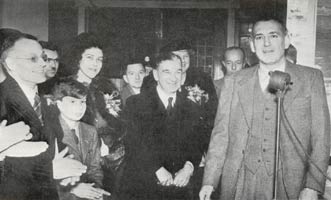 |
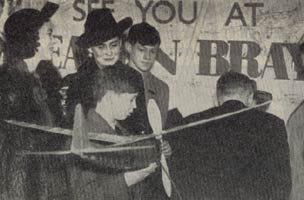 |
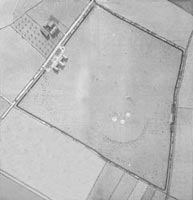 |
| DAR, Tim, Grace, Lords Winster and Balfour | Grace, Tim, Duchess of Kent and Michael | Model of Eaton Bray |
Before then however, planning permission to develop the ground as a model-flying site had been sought from Luton RDC in July 1945. The War Agricultural Executive Committee, and the town planning and ribbon development committee had already granted permission. The council informed him though that a licence would be required for any building work as with some 250,000 homes needed after the bombing, materials and work was to be aimed at housing.
In spite of this, construction started on the main building that was sited on the northern edge of the airfield, and designed by DAR in the shape of the letter E, with him being both architect and foreman. His son Michael said that it was a matter of pride that the entire building was constructed using ‘surplus’ materials. The corner footings were tubular concrete ‘pillars’ 4 foot high by 2½ feet diameter, which had previously seen service as potential mobile roadblocks in the event of an invasion. These had to have holes dug for them by hand. All the angled steel trusses were designed by DAR and built from scrap ‘angle iron’. The floor of his office was covered with the mahogany bases of the printing blocks made for AFP with the metal removed. The rest of the building had bare concrete floors, with a coconut matting covering in the office areas. Heating was by ex military coke stoves and lighting hung from the girders. The building included a bindery, research department, photographic department, editorial offices, management offices, canteen and lavatories. The consensus was that it was a rather rough building. A very prominent feature of the site in photographs and drawings was the hundreds of cylindrical concrete blocks that surrounded it and delineated the actual flying area.
 |
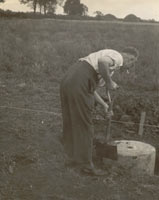 |
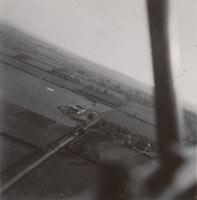 |
| In the background the E building | Albert Brentnall at work | Aerial
shot of the site Courtesy Ron Moulton |
Reporting in Sept 1945 on the progress at Eaton Bray, DAR acknowledged that things were not going quite to plan when he wrote, “With the present labour situation, not to mention the none-too-simple matter of material, the organising of Eaton Bray even to the initial stage of usefulness has been calculated to afford a headache or two. There is romance in the story of Eaton Bray, and modellers, we are sure, will be interested to hear about it when the appropriate time comes to recount it. As may well be imagined, so ambitious an undertaking did not fail to produce its crop of snags, and the way, in which they were dealt with, often in unorthodox fashion, will be worthy the telling. We are sure that modellers generally will wish the venture all the success it deserves.”
The actual site was provisionally opened on the 15th September 1945, when the weather was described as ‘squaggy’, which probably meant squally. Eddie Keil made the first ever flight that day; although the official opening was not to be until the following spring.
 |
 |
The total cost of building work up to August 1946 was £6,904 (£276,160), which was for second hand materials and wages. Relatives and staff, supplemented by wives and children, worked evenings and weekends, in an effort to try and avoid restrictions on the use of labour and the need for a licence. Grace Russell’s brother Albert who ran a small building firm was also roped in to do a lot of the building work. Staff became builders first and publishers second, taking the earlier comment about flexibility of staff to a higher level. They included those who had moved from Wilmary House to a large Victorian house called ‘Brooklands’ which had been former council offices, four miles away in Leighton Buzzard; DAR used it as his base during the week.
The approximately square 600-yard field referred to as the aerodrome, seems to have had one or more concrete circles and several people have referred to one of these being an old compass circle. Whether it was or not I have been unable to ascertain but there are several references to a concrete circle being built, as a take off area for model aircraft. Certainly by the first meeting in September 1945 the comment appeared ‘that it is not quite completed’. Tim Russell, DAR’s son recalls that ‘initially there were two concrete circles which were relatively small- a third, larger one was laid later’ which would seem to confirm that there was no existing circle. The large 72ft diameter concrete circle would become the car track, and was claimed to have the running area that was finished with emery and bath-brick as smooth as the proverbial billiard table. 24 laps of this equated to a mile and it was considered to have great potential, being able to allow cars to achieve that elusive 100mph run.
©copyrightOTW2010